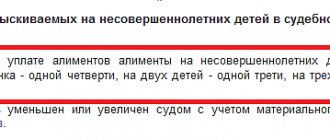Mortgage lending began to actively develop in Russia after the state adopted a maternity capital program aimed at increasing the birth rate in the country. In this regard, it is not surprising that young couples with children began to purchase their own housing on credit.
Of course, having a personal house or apartment is not a guarantee of strong marital relations and a guarantee of the absence of divorces, as a result of which some alimony providers are faced with double financial obligations, namely: the need to repay an existing mortgage and pay child support benefits. Sometimes these problems become an unbearable burden for the alimony payer. For this reason, persons obligated to pay alimony are often interested in the following questions:
- Is it allowed by law to reduce the amount of alimony due to a child if the alimony holder is simultaneously required to pay off the mortgage loan?
- Will it be considered a violation of the current legislation in the case when the payment of the mortgage goes towards alimony?
The mechanism for the occurrence of alimony obligations
There are 2 criteria by which government authorities establish the fact that an obligation to pay alimony may arise between 2 persons. These criteria are detailed in the table below.
| Family connection | Family connection |
It happens:
The family relationship is established in documents issued by the civil registry office, in particular, an adoption certificate and a birth certificate. | It exists from the moment of marriage until the moment of divorce. It is documented using a marriage certificate. However, in exceptional cases, alimony obligations may arise from a former spouse in relation to another former spouse. These include:
|
List of income taken into account in alimony obligations
- Salary, including bonuses, allowances, vacation pay and other remunerations, at the main place of work and at the place of part-time work.
- Royalties of authors and patent holders.
- Pensions and scholarships.
- Business income.
- Severance pay upon dismissal from employment.
- Income from stocks and bonds, as well as from the use of property, such as rental housing.
- Payments for compensation for damage caused by third parties to the health of the alimony.
- Amounts of financial assistance from the state and other persons.
- Compensation payments.
- Income received from the execution of civil contracts.
Methodology for calculating alimony
If the parties to the alimony obligation have entered into an alimony agreement among themselves, then they have the right to determine the amount of alimony to be paid, as well as the period of their payment at their own discretion. Below we will describe the principles for calculating the amount of alimony benefits, which are assigned by court decision.
For working people
In this case, workers will be understood as persons who are employed and officially registered with the employer, i.e. receiving “white” wages.
Entrepreneurs and investors are not included in this category because, due to the risky nature of their activities, they cannot have a stable income every month.
So, depending on the number of children the alimony payer has, he is obliged to pay maintenance in the form of:
- One fourth salary for 1 child.
- One third of the salary for 2 children.
- Half the salary for children of 3 or more.
For the unemployed
This category includes not only unemployed persons, but also:
- Persons working without registration, for example, freelancers, part-time workers.
- Persons who receive remuneration for their work in foreign currency or in kind (food products, industrial goods).
- Individuals with irregular or variable income, such as entrepreneurs or investors.
In this case, alimony can be considered by the judge for 2 reasons, described in detail in the table.
| Living wage | Written calculation of expenses for the maintenance of a minor |
The judge finds out what size of the child's subsistence minimum is established in the constituent entity of Russia in which the minor is officially registered. If the legislative bodies of a constituent entity of Russia for some reason have not determined this amount in their region, then the judge finds out what size of the children's subsistence minimum is established in Russia as a whole. For example, in Moscow it is 13,300 rubles, and in Russia as a whole it is 10,181 rubles. In most cases, the judge assigns an amount of alimony that fluctuates between 50% and 100% of the subsistence level. An increase in the amount of alimony benefits usually depends on the following factors:
| This basis is based on the principle applied in family law, which is that a child’s living conditions should not be allowed to deteriorate after the divorce of his parents. Consequently, parents, including the child support provider, must maintain the previously achieved level of well-being of the minor. How is this principle used in practice? Before going to court, the interested party collects written evidence of expenses made on the minor for a period of at least 2 months. These can be store receipts, receipts from online banks or online stores, various contracts. Next, the calculation is drawn up on a separate sheet of paper, or it is done on a computer. In it you need to calculate the average amount of spending for 1 month. For example, a mother found out that she spent 34,000 rubles to provide for her daughter. in 2 months. Therefore, the average amount of spending for 1 month is 34,000 rubles. / 2 months = 17,000 rub. This calculation with checks and receipts is attached to the claim as justification for the required amount of alimony support. In any case, the alimony recipient can count on reimbursement of at least half of the average monthly expenses for the child. In our example, 17,000 rubles. / 2 = 8,500 rub. If the alimony recipient is disabled or is forced to bear the entire burden of the mortgage loan, then alimony can amount to up to 100% of the amount indicated in the calculation. |
Alimony and mortgage: is there a relationship?
Since alimony is paid for the maintenance of a minor child, and in some cases for one of the spouses, there is no direct relationship between these deductions and the need to make mortgage payments.
In general, the principle of calculating alimony is the same as in the case of a divorce without a mortgage: for one child, 25 percent of the parent’s income is withheld, for two - 33. If there are more children, the alimony payer must transfer half of his salary to the recipient. As for alimony for the maintenance of a disabled spouse or ex-wife who is caring for a child under three years of age, the amount is determined based on the subsistence level of the region in which the recipient lives.
Thus, alimony is assigned for a mortgage; this is a fairly common practice. However, it is worth noting a few nuances:
- If during the divorce process the parties do not agree on how and when alimony is paid, and the case is resolved in court, the defendant can file a counterclaim to reduce the amount of alimony based on mortgage payments (especially if the other spouse does not pay even part of the funds) ;
- in case of debt on both payments: alimony, mortgage, and the bank goes to court, with a decision to deduct part of the borrower’s salary to pay off the debt, the accounting department will calculate payments to the bank only after payment of alimony and arrears thereon.
Features of calculating the amount of alimony in the presence of a mortgage
Before moving on to the calculation rules, an important nuance should be noted: a mortgage is not an excuse for the alimony holder to accumulate alimony debts, and also cannot be a reason to refuse to fulfill alimony obligations. Child support refers to the unconditional obligation of parents who, according to the law, must support their own children. It doesn’t matter whether parents have loans or not.
Accordingly, the maximum that an alimony payer can do is, in some cases, to raise the issue of reducing alimony payments with the court.
Mortgage taken out before marriage
According to the general rule enshrined in the Family Code, premarital property after the dissolution of marital relations is considered to belong to the former spouse who was its owner before marriage. The same rule governs premarital loan obligations. This legislative norm is not an axiom, since spouses or future spouses have the right to regulate the fate of premarital property in a marriage contract at their own discretion.
Thus, we can highlight some legal nuances in the situation when the alimony holder pays for the mortgage after a divorce and when the alimony recipient pays for the mortgage.
| Mortgage on alimony | Mortgage on alimony recipient |
| It must be taken into account that the court first of all takes into account the interests of minors regarding the payment of alimony for their support, and secondly - debt obligations. It follows that if the alimony payer has a sufficient level of income, then he will not be able to achieve a reduction in alimony payments, citing a large mortgage debt. In other words, large amounts of debt without other valid reasons will not convince the judge to reduce the amount of monthly alimony. Let us explain what sufficient income is with an example. Let’s say a man living in Moscow officially earns 65,000 rubles. in 1 month. He has 1 child, for whose maintenance he pays a quarter of his salary in the form of alimony, i.e. RUB 16,250 In addition, he pays a monthly annuity mortgage payment of RUB 30,000. The cost of living for an adult in Moscow is 17,487 rubles. The concept of “sufficient income” means that after paying loans and alimony, a man should have an amount left to live on that is higher than the minimum subsistence level established for Moscow. So, 65,000 rubles. – 16,250 rub. – 30,000 rub. = 18,750 rub. Thus, we can see that the remaining income is RUB 18,750. more than the subsistence minimum of 17,487 rubles, and, therefore, the man in our example has sufficient income and cannot count on a reduction in alimony. | In this case, the obligated person is free from the mortgage and will thus pay alimony in full if there is sufficient income. |
Mortgage taken out during marriage
According to the general rule established in the Family Code, during a divorce, all property of the spouses will be divided in half, including the mortgage loan. The rule of sufficient income also applies in this situation. If the alimony holder has enough funds to pay both half of the mortgage and alimony, and at the same time he has more money left than the minimum subsistence level, he has no right to demand in court a reduction in the monthly alimony payment.
Natalya Guzanova, General Director of North-West Legal Alliance Law Firm, answers:
The question of whether you can obtain a mortgage loan can only be considered in the context of the requirements of a particular bank, since the requirements of banks are similar, but of course there are differences (and they are always fundamental).
According to the general requirements of any bank, in order to obtain a positive conclusion on the issuance of a loan, bank employees calculate the degree of risk of the borrower’s non-fulfillment of loan obligations. To assess risk, underriders take into account the ratio of the total declared income to the amount of mandatory payments.
The amount of the applicant’s obligatory payments includes: maintenance of assets (for example, a car), maintenance of minor children (alimony), rent, the amount of money necessary for a person’s existence (from the subsistence level category), the amount of the monthly payment on the requested loan, other obligatory payments, which the applicant may not have indicated in the loan application, but the bank’s specialists saw them in the list of the applicant’s assets.
As for the payment of interest on a mortgage by an organization: in my opinion, this does not have any significant significance, since the loan obligation arises on you, and a third party (in this case, an organization) can fulfill it for you. The question of the procedure for fulfilling a loan obligation for you does not affect the bank’s decision.
Can you pay off your mortgage with alimony?
If alimony support for a child was awarded by court, then repayment of a mortgage with alimony cannot be recognized as legal. In addition, the request for the transfer of alimony for the payment of a mortgage loan, filed by the alimony recipient in court, will be rejected.
However, there is a legal way out of this situation. To do this you need the following:
- A minor recipient of alimony must either have a share in the mortgaged housing (have an extract of ownership in his name) or be registered in it.
- Parents must go to a notary and conclude an agreement on alimony in his office, in which it must be indicated that alimony will be transferred to a mortgage bank account to pay off the financial obligations of one of the parents to the bank. The price for certification of the agreement will be approximately 5,000 - 10,000 rubles.
Can alimony payments be offset against a mortgage?
According to Art. 116 of the RF IC, offset of alimony against other financial payments is not allowed, even if the child is the owner of the property. The court will not satisfy such an application, but there is another way out - to draw up an alimony agreement with the ex-wife, on the basis of which the man will repay the mortgage. This is possible provided that the minor has at least an interest in the mortgaged property.
It is important for the parties to take into account that the agreement has legal force only if notarized.
The main ways to reduce the amount of alimony if you have a mortgage
A reduction in alimony payments can only be achieved by filing a claim with a magistrate. The alimony payer has the right to choose the judge to whom he will submit the application with other papers relevant to the case:
- At your own place of registration.
- At the place of registration of the alimony recipient.
In order to be able to refer to a mortgage as one of the grounds for reducing alimony, it is necessary to prove the existence of a connection between the mortgaged housing and the child. In other words, it is necessary for the child to be registered in this housing, or to own part of the property on the right of ownership.
Next, you need to stock up on evidence that the alimony payer’s earnings have decreased due to extenuating circumstances, and not through his fault. Such circumstances include:
- Assignment of disability group.
- A serious illness requiring expensive surgery or medications.
- Retirement.
- Loss of a job due to circumstances beyond the control of the alimony provider.
- A reduction in salary that occurred by order of the employer.
- Maintenance of new dependents, for example, a pregnant wife in a new family, elderly parents.
Unfortunately, what is described above is far from a guarantee that the court will agree with the alimony provider’s arguments and reduce alimony payments. Of course, if the parent living with the child has a large salary or significant income from business, then the child support payer has a high chance of achieving his goal in this situation. In other cases, everything depends on the judge and whether he considers the circumstances described by the plaintiff to be valid or not.
How is alimony collected if you have a loan?
The distribution of mortgage obligations between former spouses is possible on a voluntary or forced basis. There are three options in total:
- Drawing up a settlement agreement on who will remain the owner of the apartment and who will pay the loan for it.
- One of the parents transfers part of the funds contributed to the loan to the second spouse and keeps the apartment for himself. Moreover, if we are talking about a parent living separately, then in addition to this he will have to pay child support.
- The mortgage loan is divided equally among citizens. Thus, the mother will have to pay only the mortgage, and the father will have to pay both the mortgage and child support obligations.
What is needed to reduce the amount of alimony obligations?
Reducing the amount of child support for a parent living separately from the child is possible only through a judicial procedure. Circumstances that serve as sufficient grounds for reducing the level of detention of a minor are:
- serious illness of the payer or his close relatives;
- the alimony worker's retirement;
- loss of ability to work;
- significant deterioration in financial situation.
To directly apply to the magistrate’s court with a request to reduce the amount of alimony, the parent must:
- write a statement of claim demanding a reduction in the amount of alimony obligations;
- describe the reasons for the need to reduce financial burden, for example, dismissal, disability or salary reduction.
- attach documents to the claim proving the legitimacy of the claims;
- transfer a package of papers to the magistrate’s court at your place of residence or at the place of residence of the second parent;
- appear at the court hearing and receive the appropriate decision.
A sample statement of claim requesting a reduction in alimony payments is available at the link below: 1d
List of documents for filing a claim for alimony reduction
You can use this sample to write your own statement of claim. Additionally, other documents may be required in court proceedings, which it is advisable to collect in advance and make 3 copies based on their originals:
- Passport data from the first 2 pages of the passport (photo + place of registration).
- Birth certificate of the minor recipient of alimony.
- A writ of execution for a court decision on alimony or an agreement on alimony.
- Loan agreement with the bank and mortgage agreement.
- Checks for payment of the monthly mortgage payment (at least 2 months).
- Pensioner's certificate (upon retirement) + certificate from the Pension Fund about the amount of the pension.
- Medical certificate of disability (if a disability group is provided).
- A medical certificate confirming inpatient treatment in a hospital, if the reason for the decrease in income is a serious illness.
- A dismissal order or an order to reduce wages if the decrease in income is due to problems at work.
- Documents confirming that the plaintiff supports other dependents (adoption certificate; court decision to claim alimony for the needs of elderly parents).
Alimony and loan debt: the most frequently asked questions
Maximum threshold for withholding under writs of execution from the payer’s income?
The alimony payer himself also needs funds for himself and for his family, so it would be wrong to take the lion’s share of earnings for collections under writs of execution, of which there may be several.
Executive services on this issue are guided by paragraph 2, paragraph 3 of Art. 99 of the Law of 02.10.07 No. 229-FZ “On Enforcement Proceedings”, which specifies the maximum amounts of deductions for writs of execution:
- 50%;
- 70%, if the penalties are intended to pay alimony for minor children, compensation for damage caused to health, compensation for damage in connection with the death of a breadwinner and compensation for damage caused by a crime.
Attention! Total deductions of alimony for all children from different wives cannot exceed 70% of the income of the alimony payer.
Perhaps you will
State duty amount
Judicial practice regarding the state fee charged for the consideration of cases of reducing alimony has not yet been established, so the courts can require payment of the fee based on 2 different principles:
- Some judges believe that such cases relate to property claims, the subject of which cannot be assessed, so they require a fee of 300 rubles to be paid.
- Other judges believe that such cases relate to property claims in which the exact value of the claims can be determined. The rules described in the table below will help you calculate the duty.
| Price of the stated requirements, in rubles. | Calculation formula |
| More than 1 million | Half a percent of the amount is paid, which is calculated according to the formula (Claim price - 1 & 000,000 rubles) + 13,200 rubles. If the amount received is more than 60,000 rubles, then 60,000 rubles are paid. |
| 200 001 – 1 000 000 | One percent of the amount is paid, which is calculated according to the formula (Claim price - 200,000 rubles) + 5,200 rubles. |
| 100 001 – 200 000 | Two percent of the amount is paid, which is calculated according to the formula (Claim price - 100,000 rubles) + 3,200 rubles. |
| 20 001 – 100 000 | Three percent of the amount is paid, which is calculated according to the formula (Claim price - 20,000 rubles) + 800 rubles. |
| Less than 20,000 | Four percent of the amount of the stated claims is paid. If the amount received is less than 400 rubles, then 400 rubles are paid. |
The fee is calculated based on the amount that the plaintiff will save in 1 year if he pays alimony at a reduced amount. Let us illustrate this with an example.
The ex-husband pays 10,000 rubles every month for child support. and plans to reduce this amount to 7,000 rubles. Thus, every month he will save 3,000 rubles, and in a year he will save 3 & 000 x 12 months. = 36,000 rub. This amount will be the cost of the claim.
Next we calculate the duty. The formula is as follows (36,000 rubles – 20,000 rubles) x 3% = 480 rubles, to which you need to add 800 rubles. As a result, we get the final amount of 1,280 rubles.
Now we need to answer the question: “How should the fee be paid if it is not known on what basis the judge will calculate it?” To do this, use the algorithm given below:
- If you have the opportunity to consult with a judge, you should ask him about the fee.
- If it is impossible to consult, then first pay a fee of 300 rubles. as for a claim, the subject of which cannot be assessed.
- If the judge returns the application and demands that the fee be recalculated according to the rules of property claims with the exact price of the claims, use the formulas given earlier in the table and the calculation example described 2 paragraphs above. After this, pay the remaining amount through the bank.
Arbitrage practice
The case was heard at court district No. 1 of the Duvan district of the Republic of Bashkortostan in July 2011.
The ex-husband demanded in court to reduce the amount of alimony he paid in favor of his son from his first marriage to one-sixth of his earnings and to completely free him from maintaining his ex-wife. The plaintiff substantiated his claims with the following facts:
- He entered into a new marital relationship, in which the plaintiff had a child. Due to the fact that the wife is on maternity leave, the plaintiff is forced to support her and the child on a monthly salary of 14,500 rubles.
- In addition, the plaintiff is obliged to pay a monthly mortgage of 6,620 rubles, a consumer loan in the amount of 1,400 rubles. and utilities 2,000 rubles.
- Based on the above circumstances, the plaintiff believes that a child from a second marriage is less wealthy than a child from a first marriage, because the ex-wife has a husband who provides for her and the child.
- He also stated that he was not obliged to support his ex-wife due to the fact that they were in a marital relationship for a short period of time, namely less than 1 year.
The defendant made objections, the meaning of which was as follows:
- The plaintiff is wrong in asserting that the defendant’s financial security is better than his. The plaintiff’s income structure consists not only of wages, but also of unofficial earnings. In addition, the plaintiff’s second wife owns a car and additionally receives child benefits.
- Satisfaction of the claim will lead to the fact that the plaintiff’s children from different marriages will not be provided for equally.
- The rule on the short duration of marriage does not apply to able-bodied persons, which includes the defendant, who worked as a lawyer before her maternity leave.
- The defendant's second husband, by law, does not have to provide for her child, because the second husband did not adopt him.
- She has no income due to maternity leave, and she does not receive child support, so alimony is the only source of funds.
Following the trial of the case, the judge decided to refuse the plaintiff for the following reasons:
- It is impossible to reduce the amount of monthly alimony collected for a child from a first marriage, because in this case he will be in a less secure position than a child from a second marriage.
- The plaintiff has a higher income and owns more expensive property than the defendant, and is thus in a better financial position. This is confirmed by information from the tax office, extracts from Rosreestr (availability of a 2-room apartment), certificates from the traffic police (availability of a foreign car for the plaintiff and Lada Priora for his second wife).
- The plaintiff's second wife, according to a certificate from her place of work, actually receives child benefits.
- The mortgage loan is paid not only by the petitioner, but also by his second spouse, with whom the petitioner shares both a common budget and common expenses.
- The defendant does not receive any child benefits and is on maternity leave, which is confirmed by a certificate from her employer.
- The rules on the short duration of a marriage or on the entry of an alimony recipient into a new marital relationship apply only to the category of disabled citizens, to which the defendant does not belong.
Housing alimony. Fathers will pay off the mortgage and pay rent
Amendments to the Family Code of the Russian Federation have come into force, obliging a parent living separately from a child to provide him not only with alimony, but also with housing. Now the court can force parents to pay the costs associated with providing the child with living quarters. And this is the first time in the history of Russian law. What parents need to know about housing support and their rights, as well as the rights of the child.
Homelessness - special circumstances
In the previous version of Article 88 of the Family Code of the Russian Federation, there was a clause that, in addition to the established alimony, the parent of a child who does not live with him is obliged, by a court decision, to reimburse the other parent for part of the additional expenses due to special circumstances. Until now, legislators have recognized only the treatment and rehabilitation of a child as such circumstances. Now these include the child’s lack of housing suitable for living. This will allow both parents to be involved after a divorce in the costs of providing housing for the child. True, there is a caveat here: the second parent, who is raising a child and receives alimony, should not have his own home suitable for living with a child, nor free funds to buy or rent it.
New responsibilities of parents
In practice, the new norms of the RF IC mean that the parent who does not live with the child, most often the father, is obliged by a court decision, in addition to paying child support, to compensate for housing costs if the child has nowhere to live. And so, it is the definition of this circumstance that baffles many. Men are interested in what to do, for example, if the mother of a child has housing, say, in Kaluga, but she went to Moscow, lives there with the child in a rented apartment and wants to receive half the money for rent plus half the cost of utility bills. Should the child's father pay housing support in this case? And if the second spouse owns two apartments, will one be taken away in favor of the child? What if the apartment is on a mortgage, which both parents must pay anyway, each for their share in the divorce? There are many nuances, which are still difficult to understand even for lawyers, because there is no practice on such alimony yet. Lawyers explain that the procedure for parents’ participation in incurring additional housing costs for the child (children) and the amount of these costs is determined by the court. The courts will make decisions based on the financial and marital status of both parents and children, as well as other relevant interests of the parties. The amount of alimony will be determined in the amount of money payable monthly.
What does it mean to “provide housing for a minor child”?
In accordance with the norms of the Family Code of the Russian Federation, both parents are equally responsible for the maintenance of the child. Thus, from a parent who does not live with the child, no more than half of the amount for renting a house, mortgage payment or the cost of an apartment that is purchased for the child can be recovered in court. The unconditional obligation of one of the parents to pay, for example, the rent of an apartment in which the second parent lives together with a minor child, is not fully established by the norms of the RF IC. The court must examine the financial and marital status of both parents and children, other noteworthy interests of the parties, and also take into account that the responsibilities of parents in relation to minor children, including additional ones, are equal. If a parent lives with a child in a rented apartment, the court will oblige the other parent to reimburse part of the rent. But, if there is an apartment, room or house in another city, the court will examine all the circumstances. In this case, housing alimony may be avoided.
In the same way, the court will take into account the fact that the spouse obligated to pay alimony may own more than one apartment, while the recipient of alimony may have nothing. Then the amount of additional expenses awarded to the alimony payer may exceed half the cost of renting a home. If a man must pay child support for several children to different women, and all these children need housing, then the payments will be divided proportionally. And if a man has dependent elderly parents, then alimony can be reduced. In addition, the alimony payer may be required to participate in partial payment of the mortgage if the parent who does not have housing purchased an apartment with the child’s share, including using maternity capital.
But the court will definitely not be able to seize an apartment from a man in favor of a child, even if he has several of them. But it may oblige the man to provide the child and his mother with housing in one of these apartments until the child reaches adulthood, with the obligation on the mother to reimburse part of the costs of maintaining the apartment.
There are many options for what housing alimony can be. As well as options for when to recognize a child as needing housing. Like, only judicial practice can give answers to most questions, and its development takes time.
Regulatory framework
| Regulatory acts | Articles of laws |
| Family code | Article 82 contains a reference to the list of income from which alimony is withheld. Article 116 establishes a ban on offsetting alimony with other requirements. Article 119 sets out a list of circumstances that allow the alimony payer to demand a reduction in alimony through the court. |
| Tax Code (Part 2) | Section 333.19 describes court fees. Article 333.24 – notary fees. |
| Decree of the Russian Government of July 18, 1996 | This list describes all categories of income from which the collection or withholding of alimony payments in favor of the alimony recipient is allowed. |












